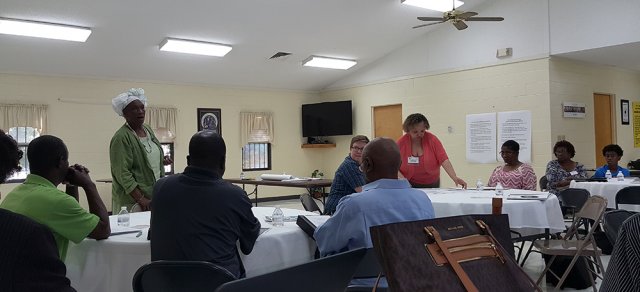Savannah Community-Port Collaboration Pilot Project
- Community-Port
Collaboration Pilot Projects - New Orleans
Pilot Project - Providence
Pilot Project - Savannah
Pilot Project - Seattle
Pilot Project
In 2016, EPA selected the Harambee House, Inc to receive EPA technical assistance and pilot a draft Community-Port Collaboration Toolkit. This pilot project was one of four pilots that were collectively known as the Near-Port Community Capacity Building Project. Harambee House applied to participate in the pilot program to strengthen collaboration between near-port communities, Georgia Ports Authority and other Port of Savannah terminal operator/owners. This page provides an overview of the pilot project. For more information, go to Case Study: Savannah Pilot (pdf) (310 KB, July 2020, EPA-420-F-20-024).
Technical Assistance

In May 2017, EPA convened the first of a series of in-person Needs Assessment meetings involving GPA, community leaders and the City of Savannah. The Needs Assessment included the following.
- Boat and bus tours of the Port of Savannah and GPA terminal facilities;
- Tour of the near-port communities; and
- Sharing of experiences and views on the status of their working relationships.
Based on the the Needs Assessment, the EPA technical assistance provider developed a draft collaboration plan with shared goals and outcomes to guide the pilot process. The plan outlined three site visits with in-person training and facilitated meetings aimed at creating a shared action plan to improve air quality for Savannah’s near-port communities. The following training was conducted: Ports Operations 101, Effective Community Engagement, and Leadership Skills-Building.
Outcomes
There were several successful outcomes from the Savannah Pilot including the following.
- Increased awareness of air quality-related health risks and truck and rail traffic health and safety concerns;
- Shared understanding about past air quality levels, current air quality trends and opportunities for continued improvement;
- Increased community understanding of technical and scientific information related to Port activities;
- Development of an environmental/public health working group of residents;
- The Air Quality Improvement Action Plan for Savannah’s Near-Port Communities, which addresses community concerns through tangible action steps; and
- Increased trust and expanded partnerships between community leaders, the City of Savannah, GPA and port-related, industry and agency partners.
Lessons Learned
The pilot resulted in the following set of insights that could be helpful to other ports communities:
- Renew relationships and build intentional partnerships;
- Be flexible and persistent with unexpected challenges;
- Provide accurate information on existing conditions and empower community leaders to gather data;
- Address participation barriers for community leaders; and
- Invest in expanding partnerships that align actions with community-defined needs and goals.
